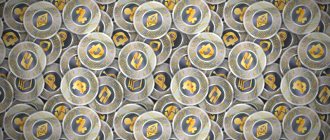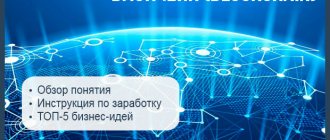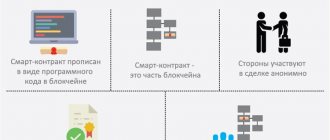How IoT (internet of things) technology works
The idea of the Internet of Things is the interaction of things with the server and with each other without significant human intervention. Basically, IoT technology is about changing how people interact with things.
The operating principle of IoT technology can be understood thanks to its structure:
- IoT devices . “Internet of things” are electronics and household appliances connected via a network, which are controlled by a single center.
- Gateways. An area that receives information from interdependent devices. Gateways convey information about the actions that the device needs to perform. Most often they are represented by routers or software.
- Server . This area stores, processes and analyzes sensor readings. Data is accumulated and processed in the cloud or in a virtual server database.
- Client part. Tracking and changing human actions through a mobile or web application. The client part provides access to indicators for different periods of time. Thanks to this access, we can monitor and control, analyze and reduce costs, if any.
The Internet of Things is not only a multitude of sensors and devices interconnected by wired and wireless networks. At the moment, this is a close integration of the real and virtual worlds, where “communication” takes place between devices and people.
Briefly, IoT technology can be explained as follows: it is the interaction of devices according to the “machine-to-machine” scheme with minimal human participation in the process.
How the Internet of Things works
A complete Internet of Things system combines four components: sensors (field devices), networking, data processing, and user interface. Let's look at what they are and how each of these components works separately.
Sensors
The main task of this block is to collect information from its environment. For example, video recording, motion analysis, temperature and humidity measurement. Sensors can be combined into one group. That is, a single device is capable of performing several functions at once.
Net
A network is a means of connecting system elements to each other. Data from sensors is sent for processing - to the cloud or local storage. To connect and send information, the following are used: Wi-Fi, Bluetooth, LPWAN broadband networks, satellite or mobile communications.
Data processing
After the data is transferred to the cloud storage, it is analyzed and compared. Operations at this stage can be simple, such as checking the temperature in the bedroom while sleeping, or complex, such as identifying objects from a broadcast video using computer vision.
Processing allows you to form a picture of the process, find out what exactly is happening in the environment, whether this is a normal state and what are the deviations from the norm.
User interface
The processed information shows the user a situation or problem. Depending on the project, these could be alerts via email, text messages, notifications in a mobile app or monitoring tool. For example, you receive a signal about the need to remotely turn off the heating system to avoid excessive energy consumption.
But as we have already said, the real Internet of things is not control by the user, but automated (independent) adjustment of the structure to changing conditions.
Application of IoT technology in different sectors
Public sector or city structure
Public transport in the city is connected to movement sensors, a person can track the time of arrival of a specific vehicle. Filling sensors are increasingly being installed on garbage cans, this allows garbage to be removed in a timely manner. Control is established over the water level in reservoirs without human intervention. Noise and pollution sensors make cities safer.
Agricultural sector
The Internet of Things has enabled agronomists to gain insight into the relative health of soils. The installed IoT technology in the form of sensors records various indicators of soil condition: moisture, plant nutrition, temperature. Now there is no need to go around the fields to control the harvest; the work can now be done by gadgets. For example, the small country of the Netherlands is actively using IoT technology, and is currently one of the world's leading countries in growing food; this became possible thanks to the use of the Internet of Things.
Logistics sector
The Internet of Things has simplified the delivery of goods from production or stores to the buyer thanks to parcel tracking. At the moment, logistics companies are actively using sensor tracking of trucks, their condition and emissions into the environment.
Construction sector
Smart Home technology is gaining the greatest popularity in the modern world. We can say that smart meters record how much energy and costs were spent on it in a certain month, the readings are transferred for payment without human intervention. This technology represents a wide range of services provided.
Internet of Things: examples inside the home
Probably, many have already heard about a smart home - these are technologies with which you can independently configure the security of your home, as well as control household appliances, for example, using your smartphone, while away from home. To do this, you need to install the appropriate application on your smartphone.
To understand why a smart home is needed, here are examples of smart home technologies:
Sensors for water and gas, more precisely, for faucets and gas burners. If there is a leak from these sensors, a message is sent to the smartphone of the owner of the apartment (house). The owner sends a command, after which the water and/or gas is forcibly shut off.
A smart RCD (residual current device), thanks to which you can selectively turn off something that is connected to electricity, for example, an iron, heated floor or lighting.
Smart night light, smart TV or refrigerator, thermostat, etc. For example, a smart refrigerator can create a list of products by analyzing the diet of the smartphone owner. The smart refrigerator also has the ability to order food delivery if it is empty.
Using your smartphone, you can start warming up your car by the time the owner leaves the house.
What is a “smart home”
The concept of “Smart Home” appeared back in 1985, when the “Unity” system was developed in the USA, which controlled home security. Currently, “Smart Home” means not only security management, the technology regulates and controls more complex processes. The Smart Home concept includes sensors and control elements, actuators that are configured and programmed to meet the needs of a specific user. Control elements receive signals from sensors and control the operation of devices that perform the task following specified algorithms. The system monitors and regulates the home's heating and cooling, burglar and fire alarms, video surveillance and lighting.
“Smart Home” combines the readings of “smart” devices and transforms them into a form convenient for the user - on a TV or smartphone screen.
The main goal of the “Internet of Things” and in particular the “Smart Home” is simplification and significant saving of money and time. Developers of IoT technology have also made a big step forward into a not-so-obvious but important area of healthcare – medicine.
What is the Internet of Things in simple examples?
In its ideal vision, the Internet of Things is what connects home, city services, transportation and all kinds of commercial services within one global unified data exchange network.
In reality, the technology is limited by the difficulty of establishing a reliable connection (communications are not good everywhere) and high cost (an LED smart light bulb with a modem will always be more expensive than the conventional “Ilyich Light Bulb”), so the use of an IoT system should be truly in demand.
Here are examples of those who are using IoT now:
- you find out directly from your phone where the postal parcel is located;
- owner of several fuel trucks - do the drivers have time to bring fuel to the gas station;
- a resident of a “smart home” orders food directly from the refrigerator or turns on the air conditioner from his phone;
- the fire department instantly receives notification of a fire somewhere in the forest or in a factory;
- the director of the company manages the equipment and monitors the production flow without leaving the office;
- The logistician monitors warehouses and transport to identify defects and optimize delivery speed.
Development of “smart medicine” over five years
Analysts at Markets and Markets believe that in the next five years, medicine will become the fastest growing segment of the Internet of Things.
The Internet of Things in medicine is a network of connected medical devices that collect data and transmit it to an IT system for further analysis. Devices can be wearables, mobile apps, tablets, smart beds and smart meters.
Technology - IoT in medicine will change patient treatment, condition tracking, information collection.
Solutions - IoT will provide data on the current condition of the patient, monitor its changes and automatically warn of potential problems before they become critical. Data analysis using devices aims to improve diagnosis of patient conditions. Constant monitoring of patients will allow doctors to have a holistic and up-to-date picture.
Sensors and smart devices with mobile and web applications will reduce the use of energy-intensive medical equipment and reduce operating costs.
Smart pills, wireless patches, a medicine box that reminds you when to take your medicine, and a loud alarm when a pill is forgotten are examples of medical IoT devices.
Problems of development of IoT (Internet of Things) platforms
The existing relations between development companies - competition and cooperation, allow us to hope that in the coming years the main problems will be resolved:
- Standardization.
- Creating workable platforms with a functional central element.
- Security.
- Reliability and performance of network systems.
- Taking into account the individual characteristics of a particular user (for example, people with limited functionality).
Breakthroughs in these areas will improve the quality of solutions in analytics and management in IoT projects. As a result, a significant improvement in the quality of life will be achieved in all areas and at all levels - from household to corporate, state and global.
“Smart retail” or what the stores of the future will look like
In the future, sensors, beacons and other IoT devices will provide a personalized experience for each customer. The Internet of Things will tell you where the connected customer is and how to find the product they need.
So the seller has complete information about the potential buyer: what he eats, what size of clothes, what brands he prefers. Thus, he can instantly send a notification through the application about new products, goods, promotions and special offers when a potential buyer crosses the threshold of the store.
Real-time analytics. IoT technology will provide analysis of the number of units sold and will monitor leading products. If the main factor when choosing a product is price, then the technology will automatically adjust the price down or up in order to achieve maximum sales volume.
In the next five years, stores and factories will use IoT technology in their work. This technology will affect inventory in the warehouse. The technology will allow you to track purchases and delivery, ensure there is no oversupply of goods that are not in demand, and will establish a supply system. IoT technologies will be able to provide companies and stores with a reduction in variable and fixed costs, adjust supply and demand, and most importantly, you won’t even have to spend money on additional staff.
The Internet of Things will soon change the way people think about shopping and will simplify this process thanks to automation.
What are the benefits of Internet of Things (IOT):
- The network of things reacts to events around it and automatically makes decisions: for example, it changes the temperature in the room or warns about a lack of oxygen and the need to ventilate the room. But in the future, notifications and warnings will disappear: “things” will adapt to the situation without demand.
- Smart homes from Google, Amazon and Apple are nothing new. And a better basic example connecting the real and the virtual cannot be found. Remotely, with the help of wireless networks and voice dialing, owners of apartments crammed with technology are able to order groceries and change lighting, communicate with friends and check whether the iron is turned off. Soon, houses will become even “smarter”: automatic detection of passers-by, calling an ambulance, cleaning.
- The IOT concept is based on long-known (and no longer seemingly unthinkable) technologies of wireless sensor networks, united by radio channels for data transmission (monitoring, statistics, logistics, commands for execution), and RFID - radio frequency identification of physical objects.
- IOT is also useful in business: it helps automate many things. Calculate the route to the client, taking into account traffic jams or transfers, reduce electricity costs and even eliminate the factor of human errors in production.
Security hinders the approaching progress. Hackers in the future will turn into cyber criminals, remotely hacking networks (video surveillance, monitoring and analysis) and transmitting incorrect coordinates. The results of the hack are hard to even imagine: mixed-up patient tests, trucks with goods arriving not at clients but at private parking lots, redistribution of energy. In addition to safety, we must not forget about the fate of man in a world ruled by machines. Job losses will lead to financial uncertainties.
Wearable devices
“Smart” assistants in the form of wearable devices on the hand have gained enormous popularity. These are Internet of Things devices that measure human physical indicators. “Smart” bracelets are full-fledged gadgets for monitoring health. The devices also count steps, analyze activity and provide a report to the user. Analysts estimate that in 2025 the number of Internet of Things gadgets will be about 27 billion units, compared to 8.5 billion today.
In the future, large-scale development of various bracelets is planned. For example, bracelets that provide emergency assistance to soldiers by monitoring the effects of sunlight on human skin. The idea of paired bracelets has gained the greatest popularity, as the principle of operation has become attractive to many lovers: when one bracelet touches, a signal is transmitted across a distance to another person. Interaction across distance has proven to be an inspiring IoT technology. Wearable devices of the future will provide visual contact with a doctor, friend or partner.
Smart cars
Many people have already driven a smart car, and most of them believe that this is one of the best uses of IoT. At the moment we can use sensors and an Internet connection, warming up the car in advance. All this guarantees us maximum comfort.
Thus, self-driving cars will soon change our understanding of reality. We will see taxis controlled by artificial intelligence.
“Smart cars” will independently assess the situation on the road and adjust the route without human intervention. With the development of IoT technology, cars will not be able to do without an Internet connection. It will be used to update transport maps and assess the traffic situation.
Internet of Things what is it?
I think that everyone is familiar with the concept of artificial intelligence, especially as the information sphere develops, gadgets become smarter and more suitable for each of us.
To put it very simply and quite generally, the Internet of Things is an entire system of devices that allows you to automate life by adjusting the operation of equipment and programs to suit you: a kettle that boils at a set time, a bathroom that is filled by the time the owner returns home.
But it would be too banal if we were talking exclusively about everyday problems. In fact, the system is a way of connecting machine to machine without human intervention, called M2M. Along with this statement, it is customary to say that the big data that devices generate is the same IoT, but at the same time, by analyzing it in the future, we can make different decisions, increase comfort, and build a business with minimal costs and losses.
In fact, the Internet of Things can be viewed from several fundamental perspectives:
- a network of interconnected objects;
- devices that operate and are controlled remotely;
- ecosystem - a large-scale network, including within the state;
- control panels for monitoring processes;
- analytics using a large number of scenarios.
And I want to note that IOT is presented at several levels:
- physical - the entire technical base;
- network is responsible for collecting and sending data;
- the application layer is responsible for interfaces;
- planetary (there are unnecessary explanations here).


